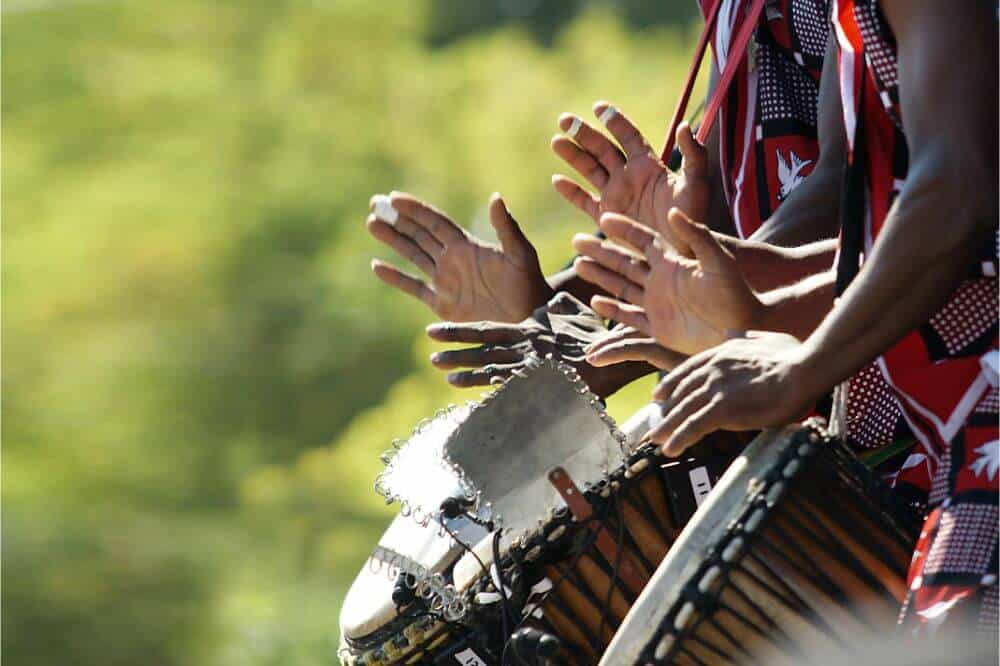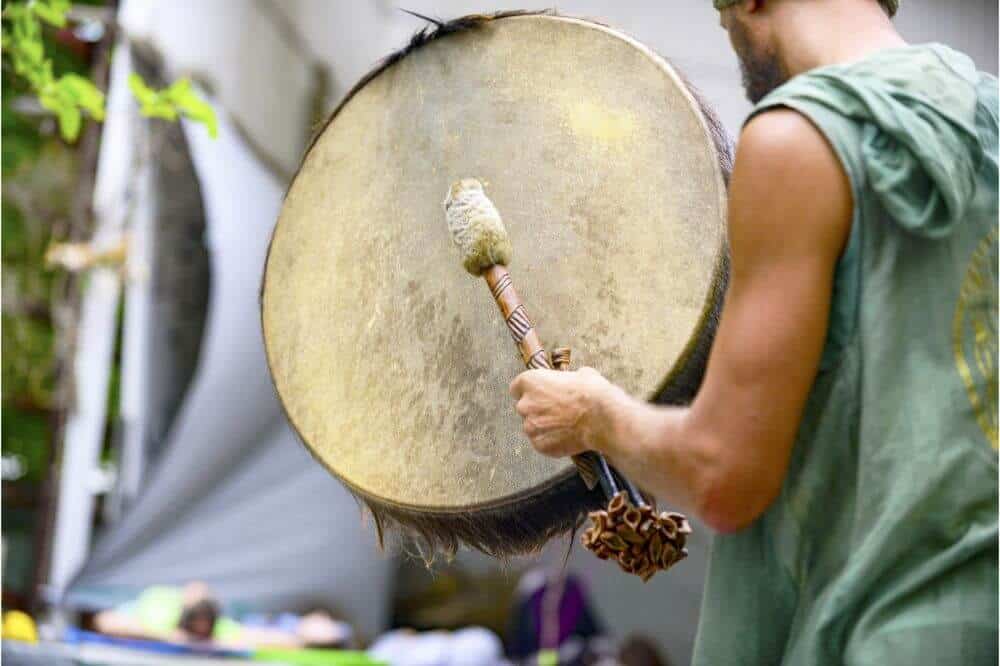Tribal drums have been around for thousands of years, and as you can guess by the name, each drum is generally associated with a different culture or tribe. Tribal drums are more than just musical instruments, as they also have deep-rooted spiritual and religious meanings.
Although today we don’t want to get into the spiritual side, we want to talk about some of the type of tribal drums you may encounter.
Africa is well-known for having a diverse array of tribes, and therefore tribal drums, so our focus will be heavily on Africa, but we will touch on other areas of the world.
Types of Tribal Drums
African Tribal Drums
As mentioned above, Africa is our focus today because many tribal drums and percussion instruments can be traced back to Africa.
The Tama
One popular tribal drum in Africa is the Tama, also known as the talking drum. This drum is made of various materials and usually features canvas on top but can also be made out of animal hide. The Tama’s defining feature is that it has vertical strings that run from the top to the bottom along the entire circumference.
By squeezing the strings, the pitch of the drum can be changed. The Tama is played with a unique curved stick.
The Djembe
One of the most common and well-known African tribal drums is the Djembe. This is a large drum shaped like a goblet, and it has its origins with the Mandinka people of West Africa. It has become prevalent in the West in recent decades.
One feature of this drum is that it’s very dynamic, producing deep, pounding, and higher slap-like tones.
These drums are usually carved of wood and feature goatskin heads (although modern ones may use synthetic materials). They are generally played by hand, although one or two sticks can be used as well.
The Djun Djun
The Djun Djun is a type of West African rope-tuned drum, and just like with the Tama, the pitch of the drum can be changed by squeezing the strings. This drum comes in many different sizes, and it usually features a wooden body with drum heads at both ends made of goat or sheepskin.
These are played using a stick or a mallet, sometimes with a bell, and are often played alongside the Djembe.
The Udu
The udu is a percussive instrument that some may define as a drum, although it is actually a large clay pot with a narrow opening at the top and a small hole in the side. This is a drum that is native to Nigeria.
This drum is played by using one hand to beat the drum’s clay surface, while the other hand is used to partially or fully cover the hole on the side, which results in a beautiful diversity of pitch and tone. There is also a variation of this drum known as the ibo.
The Cuica
One of the more unique African tribal drums is the cuica, a high-pitched drum made of various materials. However, wood is traditional, and it features a single head, traditionally made of sheep or goatskin. What defines this drum is a horizontal bamboo rod placed perpendicular to the drum’s head, on the interior.
The cuica is played by using moistened fingers to rub the stick with one hand while applying pressure to the drum’s head.

Native American Tribal Drums
There’s no way to ignore the diverse array of tribal drums created and played by the native peoples who have lived in North America for thousands of years.
The Hand Drum
One of the most common types of Native American tribal drums is the hand drum. These can come in many varieties, with the most common one being a double-sided hoop drum with rawhide on both sides. The first drum like this was initially used by the Tarahumara tribe.
One variation of the hand drum that you and your kids might be familiar with is the rope drum, a very small drum with a vertical handle and two small ropes and a ball on each rope.
The drum is held between both hands by the upright handle and spun back and forth, causing the balls to hit the heads.
The Foot Drum
Although foot drums are rare nowadays, not too long ago, many North American native tribes used them widely. Foot drums are generally made by placing hollowed-out logs over openings in the ground that produce a drum-like noise when beat.
The Water Drum
One of the most unique types of Native American tribal drums is the water drum, which was first made by the Iroquois tribes of North America. Iroquois water drums are small and wooden, with a tanned hide, and they can be filled with water to change the tone.
Another popular variation is the Yaqui water drum, a gourd cut in half with a water-filled basin, then hit with a drum, causing the water to resonate.
The Pow Wow Drum
One of the most popular North American and Native American tribal drums is the pow wow drum, a very large and loud drum with a deep voice. It is used in drum circles where multiple people beat it.
These drums are usually made of cedarwood and feature animal skin or rawhide heads, complete with short legs to form a base.
Other Tribal Drums from Around the World
There are so many cultures, each with their own tribal drums, that this article could be a whole book. That said, let’s quickly list some of the most popular and common tribal drums from around the world.
Indian Tribal Drums
Tabla Drums
Indian drums that require precise and advanced finger technique, known for their very unique sounds.
The Kanjira
From Southern India, somewhat similar to a tambourine. It’s made of wood and traditionally features a lizard skin head.
Celtic Tribal Drums
Bones
Technically a type of tribal drum from Ireland, with origins in Celtic traditions. They are actually two bones that are beaten together to make a sound.
The Bodhran
This is a straightforward wooden drum with a single head, open on the bottom, and features a small handle.
Middle Eastern Tribal Drums
The Tar
The Tar is one of the oldest frame drums found in images of Turkish shrines dating back more than 8,000 years. They have deep religious connotations.
The Doumbek
This drum is the Middle-Eastern version of the Djembe, a goblet-shaped drum that features dynamic tones with a metallic sound.
Finger Cymbals
Although not strictly a drum per se, finger cymbals do have tribal origins.
Basque Region Tribal Drum
The Txalaparta
The Txalaparta is an instrument from the old Basque country of Spain and is typically played by two musicians. In the region of Navarre, the drum-like instrument’s name is said to hail from images of trotting horses. Below you can see a clip of the instrument in action.
Conclusion
We only scratched the surface, as there are literally hundreds of tribal drums from around the world. Some can date back thousands of years, and they all have distinct sounds.

